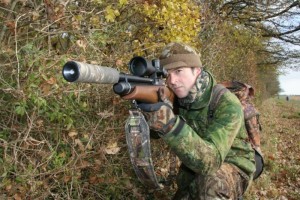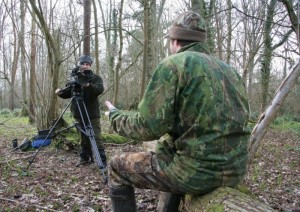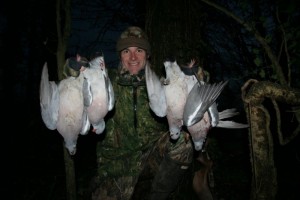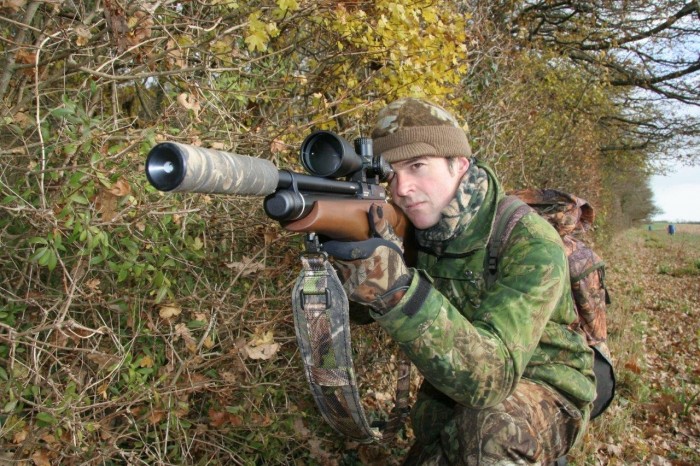Here at Pellpax, we’re proud to bring you an interview with a very special featured guest. In the world of airguns, Mat Manning is that rarest of things: A bone-fide celebrity. Mat works for Blaze Publishing Ltd, and is deputy editor of Airgun Shooter magazine. You may recognise him as being presenter of The Airgun Show, which regularly airs on Youtube. He is also the author of Air Rifle Hunting Through the Seasons: A Guide to Fieldcraft and Hunting with Air Rifles: The Complete Guide.

Tell us about your childhood, and what brought you to shooting?
I was outdoors for most of it. My grandad was a herdsman on a Somerset farm, not far from where I grew up, and I spent a lot of time there, helping grandad and doing a lot of fishing with my uncle Kevin – Mum’s little brother. Kev was actually closer in age to me than he was to mum.
I started shooting when I was ten. I loved it. Kev would lend me his old Webley Vulcan airgun, and I’d tag along with him whenever I got the chance. Kev and I still go out shooting together – he’s one of the cameramen on The Airgun Show.
Having a grandad in the farming network was a great help when it came to obtaining shooting permission. My ears would prick up at the mention of pests, and I’d be in there!
You’re coming up for forty. Career-wise, are you where you planned to be twenty years ago?
Well, yes. As a youngster, I wasn’t really sure what I wanted to do. I wasn’t a good scholar – I messed about too much – but I loved writing, and I knew I was good at it. At sixteen, though, I went off to Cannington College (a residential agricultural college) to study Countryside Management. I already had a very keen interest in wildlife and conservation, and I was familiar with the concept of balancing wild and domestic habitats. I never forgot about writing, though. In 1999, I went off to Glamorgan University to study journalism.
How did you do?
Got a First.
Excellent!
So yes, I wanted my career to be a combination of writing and shooting. Talking to a camera, though … that was a shock to the system! It’s a lot less forgiving than having time to compose your words on a keyboard, but it’s a challenge I’ve embraced, and I reckon I’m getting the hang of it now. Some of our films have had around 300,000 views, so we must be doing something right.
Tell us about your early career – those first jobs after studying.
For three years, after agricultural college, I worked for a woodland management company and also on a game farm. The work was seasonal, so these two occupations complemented one another well.
During the colder months – September to April – I’d be working on a chainsaw. This included the regeneration of hazel coppices, hedge-laying, and woodland thinning. You see, when the canopy is dense, there’s not enough sunlight on the woodland floor – nothing can germinate, so you don’t get any regeneration. By taking out some of the mature trees, you let the light in, wild flowers and young trees flourish, and biodiversity is improved.

Summer work was game rearing, and I also played an active role in pest control. The introduced grey squirrel population is detrimental to a lot of native wildlife – and not just the red squirrel. Greys are very partial to eggs, and they’ll even eat newly hatched birds. This has a destructive effect on songbirds and game birds. The squirrel’s taste for tree sap also causes major damage when they strip bark to get to the syrupy liquid beneath. It deforms trees and can also kill them. This habit makes the grey squirrel an enemy of foresters and also impacts on the habitat needed by our indigenous wildlife.
During these three years, I wrote an occasional article for shooting and fishing publications. I was itching to write, so, at twenty-three, I went off to Glamorgan to study Journalism.
My first ‘proper’ job as a journalist was with the Blackmore Vale Magazine. As a news reporter, I was thrown in at the deep end, covering anything from crime to planning and business, from sport to food and farming. It was great; bashing out 10,000 words of news a week is pretty good grounding for a career in what is a very hectic industry.
I also had my own shooting and fishing page called ‘Field and Stream’. At twenty-six, I had a lot of knowledge and experience when it came to wildlife and countryside issues. And I loved writing. This was a really good job for me – especially with the extra training provided by Trinity Mirror, which owned the magazine at that time. I spent twelve years at the Blackmore Vale magazine in various roles, including Content Editor.
You’re really busy at the moment with Blaze Publishing. Tell us about what you do.
Well – I’m Deputy Editor of the Airgun Shooter magazine, which is a four-weekly publication dedicated to all aspects of airgun shooting. I’d been a freelance contributor for shooting magazines for more than ten years, but presenting on The Airgun Show was completely new to me – as you can see if you look back at the early episodes!
Normally, I’d be hunting alone. Moving around with someone else, who’s weighed down with camera and sound equipment, is very different to your usual shooting experience. And it’s even trickier when we use the scope camera. This is a marvellous bit of equipment that allows your audience to see what you’re seeing, as you’re actually shooting. It takes some getting used to, though. The camera is fixed to the scope, while the shooter has to look off to one side at the little monitor. This means that the gun isn’t nestled snugly into your shoulder, and you find that it’s more difficult to hold it steady.

I try to make the best use of shot quarry that I possibly can. If it’s good for the table, I take it home with me and make burgers, sausages, pies, pasties, stews … and I save magpie and jay wing feathers, and squirrel tails too – the fibres are great for tying fly hooks and are always gratefully received by fly-fishing friends! It’s important to understand why you are killing. Conservation depends on achieving a balance. Population growth in a struggling species can sometimes only be achieved by the suppression of another. However, I feel that it’s vital to make the best use of culled animals.
Mat – we all want to know: what’s your favourite airgun?
Not telling!
Only joking. It’s a Daystate Mk 4 – a PCP (pre-charged pneumatic) air rifle, fitted with Daystate’s patented MCT – that’s ‘map compensated technology’. That’s my favourite at the moment, though I’m also very impressed with the latest incarnation of Daystate’s electronic firing system in the Pulsar. My Mk 4 is FAC-rated, but I also have several legal limit (sub-12 ft/lb) airguns in my collection. My Air Arms Ultimate Sporter and BSA Ultra SE see a lot of action.
You can grab a Daystate Mk4 PCP air rifle, Air Arms Ultimate Sporter and BSA Ultra SE from the PCP Air Rifles section on our webstore.

